Overview
- Features: Royal palace of the Wodeyar family with opulent interior decorations
- Opening Times: 10:00 am to 5:30 pm, daily
- Best Time to Visit: Any time of year
- Duration: 2 to 3 hours
- Travelled By: Bus, Auto rickshaw
- Cost: Indian/foreigner Rs 20/200
- Address: Sayyaji Rao Road, Mysore, Karnataka, India
- Type: Palace
Author Reviews[display_rating_item_results rating_form_id=”2″ rating_entry_ids=”1″ show_category_filter=”false” show_options=”true” result_type=”star_rating” preserve_max_rating=”true” show_title=”false” show_count=”false” ]
Total Rating: [display_rating_result rating_form_id=”2″ show_count=”false” show_rich_snippets=true] [accordions load=”1″] [accordion title=”User Reviews” last] [display_rating_item_results rating_form_id=”5″ show_options=”true” result_type=”star_rating” preserve_max_rating=”true” show_title=”false” show_count=”true” show_rich_snippets=true] [/accordion] [accordion title=”Add Review”][display_rating_form show_email_input=”true” show_comment_textarea=”true” show_name_input=”true” rating_form_id=”5″] [/accordion] [/accordions]
Summary
Among the grandest of India’s royal buildings, the Mysore Palace, also known as Amba Vilas Palace, is the official residence of the Wodeyars, the Maharajas of Mysore, the former royal family of Mysore, who ruled the princely state from 1399 to 1950. The palace was built in the Indo-Saracenic style which blends Hindu, Muslim, Rajput, and Gothic styles of architecture.
Mysore Palace
Among the grandest of India’s royal buildings, the Mysore Palace, also known as Amba Vilas Palace, is the official residence of the Wodeyars, the Maharajas of Mysore, the former royal family of Mysore, who ruled the princely state from 1399 to 1950. The old palace was gutted by a fire in 1897; the current building with its domes, turrets, arches and colonnades was completed in 1912 by English architect Henry Irwin at a cost of Rs 4.5 million.
The palace was built in the Indo-Saracenic style which blends Hindu, Muslim, Rajput, and Gothic styles of architecture. It is a three-stone structure with marble domes and a five-story tower. The palace is surrounded by a large garden. The entrance gate and arch hold the emblem and coat of arms of the kingdom of Mysore, around which is written the kingdom’s motto in Sanskrit: translated as “never terrified”.
The Mysore Palace has three entrances: the East Gate (the front gate, opened only during Dasara and for VIPs), the South Entrance (for public), and the West Entrance (opened only during Dasara). In addition, there are numerous secret tunnels from the palace cellar leading to Srirangapatnam, other palaces, and confidential areas.
[singlepic id=1457 w=720 h=560 float=center]
The three-story stone building of fine gray granite with deep pink marble domes has a facade with several expansive arches and two smaller ones flanking the central arch, which is supported by tall pillars. Above the central arch is a sculpture of Gajalakshmi, the goddess of wealth, prosperity, good luck and abundance with her elephants.
[singlepic id=1453 w=720 h=560 float=center]
There are three major temple buildings within the Old Fort, and about 18 inside the palace building. The Maharajas of Mysore were devotees of Goddess Chamundi, which is why the place faces Chamundi Hill.
The interior of the Mysore Palace, with its carved pillars and shiny marble floors, is just as opulent as its exterior.The decor is further embellished by a kaleidoscope of stained glass, carved wooden doors inlaid with ivory and a series of wall paintings depicting the life in Mysore during the Edwardian Raj. The fabulous collection of jewels is seldom displayed while the ornate golden throne is only displayed during Dasara.
Gombe Thotti (Dolls’ Pavillion)
On the ground floor, visitors are led into the palace through the ‘Car Passage’ with cannons and carriages to the Gombe thotti (Dolls’ pavilion). This originally displayed traditional dolls from the nineteenth and early twentieth centuries. Today it houses a model of the old palace, European marble statues and a wooden elephant howdah (frame to carry passengers) decorated with 84 kilograms of gold. The maharaja used the battery-operated red and green bulbs on top of the canopy as stop and go signals to the mahout. The last is still used during Dasara but goddess Chamundeshwari rides on the elephant.
Kalyana Mantapa (Marriage Hall)
South of the courtyard, the Kalyana Mantapa, or marriage hall, is a grand, octagonal-shaped pavilion with a multi-hued stained glass ceiling with peacock motifs arranged in geometrical patterns. The entire structure was wrought in Glasgow, Scotland.
The floor also displays a peacock mosaic, designed with tiles from England. Oil paintings illustrating the royal procession and Dasara celebrations of bygone years are displayed on 26 canvas panels on the walls. Note the exquisite details, especially of No 19.
The Portrait Gallery and the Period Furniture Room lead off this pavilion.
Public Durbar Hall
On the first floor, a marble staircase leads to the magnificent Durbar Hall for public audiences where the general population could meet the king at scheduled times to submit petitions. The durbar hall is a richly decorated gold-and-turquoise colonnaded hall with lavishly framed paintings by famous Indian artists. A series of paintings on the rear wall shows the goddess Durga in her various forms. The asbestos-lined ceiling has paintings of Vishnu incarnations.
Amba Vilas Hall
A passage takes you past the beautifully ivory-on-wood inlaid door of the Ganesh Temple, to the Amba Vilas where private audiences (Diwan-i-Khas) were held. It was here where the king would confer with his ministers. It was also the chamber in which he gave audience to people deserving special attention. This exquisitely decorated hall has three doors. Entry to this opulent hall is through an elegantly carved silver rosewood doorway inlaid with ivory that opens into a shrine dedicated to Ganesha. The central silver door depicts Vishnu’s 10 incarnations and the eight dikpalas (directional guardians), with Krishna figures on the reverse, all done in repoussé on teak and rosewood. The room sports an art nouveau style while the central nave of the hall has ornately gilded columns, Belgian stained glass ceilings, decorative steel grills, etched glass windows and chandeliers with fine floral motifs, mirrored in the pietra dura mosaic floor embellished with semi-precious stones. The central part of its ceiling is supported by cast-iron columns and arches from Glasgow.
The jewel-encrusted Golden Throne, with its ornate steps which some like to attribute to ancient Vedic times, was originally made of fig-wood overlaid with ivory before it was padded out with gold, silver and jewels. Others trace its history to 1336 when the Vijayanagar kings ‘found’ it before passing it on to the Wodeyars who continue to use it during Dasara celebrations.
Maharaja’s Residence
The Maharaja’s Residence is a slightly underwhelming museum. The ground floor museum displays children’s toys, musical instruments, costumes and several portraits. The upper floor has a small weapon collection used by the members of the royal family. It contains lances, cutlasses, and other 14th century weapons as well as those used in the early twentieth century, such as pistols.
Mysore Dasara Festival
Every autumn, the Mysore Palace is the venue for the famous Mysore Dasara festival, during which leading artists perform on a stage set up in the palace grounds. On the tenth day of the festival known as Vijaya Dashami, a parade with caparisoned elephants and floats originate from the palace grounds.
Dasara is the most extravagant festival in Mysore. The Dasara festival is celebrated in September and October of each year. The festival celebrates and commemorates the victory of the great Goddess Durga, also called Chamundeshwari, after she slew the demon Mahishasura, thereby symbolizing the triumph of good over evil according to Hindu mythology.
This festival has been celebrated by the Wodeyars at Srirangapatnam since 1610, and in Mysore with great pomp since 1799. The tradition is still carried on, although the scale of the celebrations has diminished. The Dasara festivities have become an integral part of the culture and life in Mysore. To celebrate this festival, the Palace of Mysore is illuminated with more than 96,000 lights during the two-month period.
Visitors Information
Between 7:00 and 7:45 pm every Sunday, on national holidays, and through the Dasara celebrations, the palace is illuminated by nearly 100,000 light bulbs that accent its majestic profile against the night.
A sound and light show is arranged daily between 7:00 and 7:45 pm, except on Sundays and public holidays.
While you are allowed to snap the palace’s exterior, photography within is strictly prohibited. Cameras must be deposited in lockers (Rs 5) at the palace entrance.
Also available within the compound is a multilingual guided audio tour of the palace, the price of which is included in the foreigner’s ticket.
Footwear is to be removed before entering the palace complex.
Getting to & from Mysore Palace
Mysore Palace can be accessed by bus, auto rickshaw, taxi or private car. The palace is ten minutes away from the city bus stand which is the most affordable way to get here. The most convenient and direct way is to take an auto rickshaw or taxi which will drop you right in front of the palace. Alternatively, you can arrange a private car with chauffeur from a reputable hotel or travel agency in town.



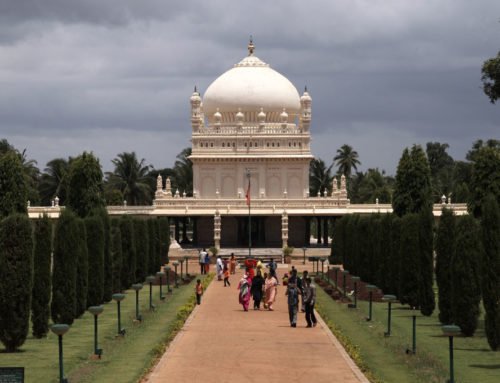
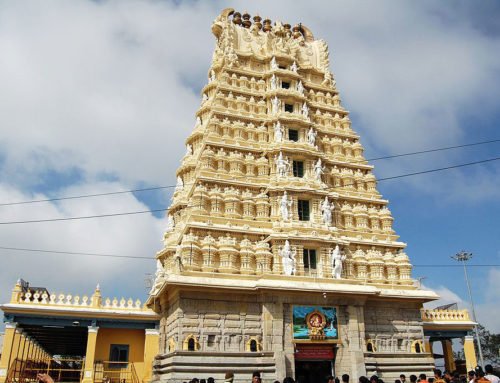
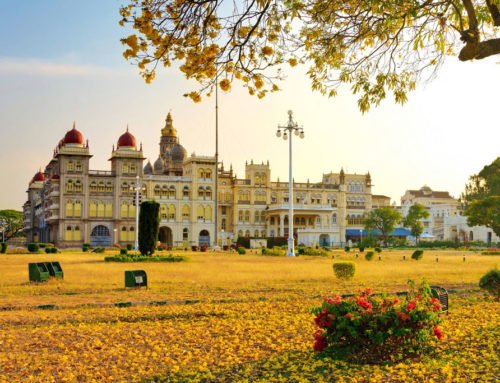
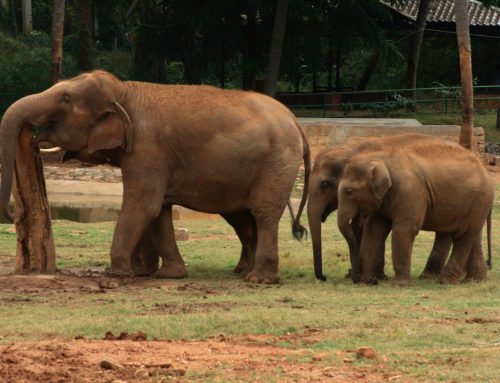
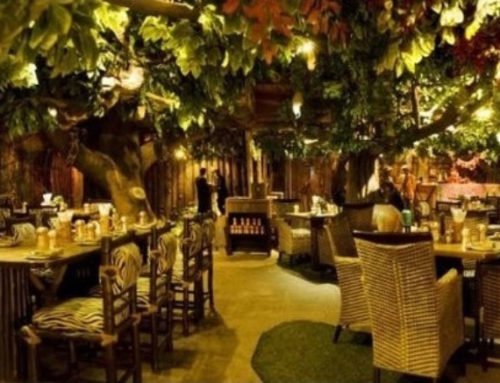
Saved as a favorite, I like your web site!
Hi John,
That’s fantastic! We hope to see you again on our website.
Helpful info. Lucky me I found your web site unintentionally, and I bookmarked it.
Hi Jade,
We’re so glad you found our website and liked it. Our aim is to provide new and useful information on travel locations in India for users like you. With new posts uploaded daily, there’s plenty of new information to read.